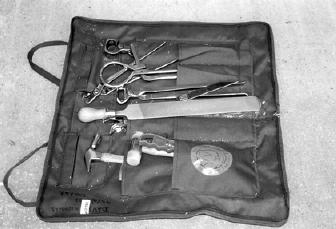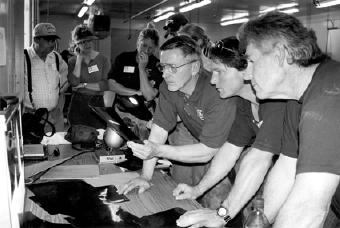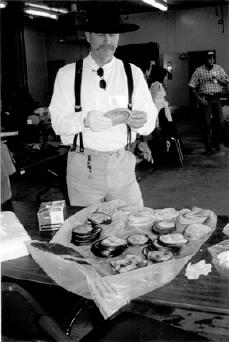| Published in the July 2001 Issue of Anvil Magazine
Perhaps the blind still couldn't see, but the lame could indeed walk-and much more comfortably-at the SoundFest Conference, held March 28 - 31, 2001, at UC Davis, sponsored by Mission Farrier School. It was truly a week of miracles for the nine difficult- case horses involved, as Natural Balance shoeing principles were put to the test. In fact, the results of the clinic would make a believer out of even the most skeptical of critics.
Image: Latest in rocker toe technology! Natural Balance-shod front foot on "Feature Attraction" and Nike shoe on owner, Kelly Irving. "I didn't used to feel that Natural Balance was a very good method of shoeing, because I hadn't seen it done well," says Dr. Joyce Harman, wholistic veterinarian from Virginia and featured speaker at the event. (See interview, page 10, this issue) "If you apply only half the principles of Natural Balance and half the principles of the more traditional shoeing methods, that doesn't work." Due to misapplication of the product or mis-preparation of the foot, Natural Balance has received its share of bad press, so it was refreshing to see the 70 eager faces in attendance. There were veterinarians and farriers-students to journeymen-soaking in the scientific research and proof-in-the-pudding case studies supporting correct application of the innovative method. Now that I understand the principles of Natural Balance and I've seen it applied correctly, I am convinced that it makes the most biomechanical sense for the horse, and that we are on the right track," Dr. Harman said. "The method enables the horses I work with to hold their chiropractic adjustments better, and in fact they seem to need less adjustments than with other shoeing methods."
Image: Farrier/Clinician Gene Ovnicek oversaw application of the Natural Balance, Equine Digit Support System Products. Dr. Ashton Cloninger, Northern California equine sports medicine specialist who has spent over 20 years working the racetrack, stated: "I'm convinced that applying Natural Balance principles works. It's a whole lot of fun to watch horses finally get happy, and the horse owners as well. Some of the owners have been struggling for a very long time so it's gratifying to watch them smile as the horse walks off, traveling well in the course of just one shoeing. With Natural Balance you can innovate and make adjustments on the spot with the tool provided." Michigan State University researcher and bioneurologist Dr. Robert Bowker (see ANVIL Magazine interview, March, 1999) enthusiastically presented his recent findings in four lectures entitled: Functional Anatomy of the Palmar Foot; Navicular Syndrome; Hoof Wall-Laminae and Changes and Environmental vs. Genetic Influences. Gene Ovnicek presented his all-new lecture containing the latest findings in the studies on feral horse feet, as well as veterinarian/farrier relationships, and Dr. Harman spoke on the topics of: Saddle Fit (including hands-on participation lab), Negative PIII Plane (including roundtable discussion), and Natural Treatment of Chronic Laminitis. Located in the Animal Science horse barns at the lush, blossom-laden University of California, Davis campus, the event consisted of a combination of lectures and hands-on teamwork. Each afternoon, veterinarians and farriers worked together on a variety of special-case horses ranging from unsound, poor movers to clubfooted, laminitic and navicular ones, and even a couple of coffin bone fractures.
Image Each day three teams, consisting of four farriers and one veterinarian, were assigned to a horse to diagnose and shoe. They were given the case history on the horse, including radiographs from that morning and any pertinent ones from before, and then set out to work. As they hustled back and forth between the radiographic viewing areas, shoeing rigs and the horses, each team decided upon the most optimal overall approach for their case. The horses benefitted not only from the latest breakthroughs in shoeing techniques, but also chiropractic, manipulative body work, and saddle fit review. With the advantage of full radiographic capabilities on the premises, comparison of `after' radiographs enabled immediate feedback as to improved angles, breakover, and function. Some horses required modest alterations to the team's approach after radiographing, in order to fine tune the most optimal function. Most of all, the horses moved better when the team's work was done.
One of the horses that was a difficult case came all the way from Washington
State to be shod at the clinic. "Feature Attraction," a nine-year old chestnut
Hanovarian owned by Kelly Irving of Gig Harbor, is used for dressage. Having
had stretched tendons as a foal, Feature was malnourished early in life,
and Dr. Joyce Harman speculated that he was also windswept at birth.
Unfortunately, the gelding has had a history of lameness for the past four
years since Kelly has owned him. His issues included resistance to work-
especially lateral work to the right -and saddle fit problems. He had been
barefoot for the past two years, as he had been unable to be kept sound in
shoes of any kind. The team that worked on Feature discovered that he had
a high heel on his right front foot. His left front foot had a low heel and
the leg noticeably winged out. Radiographs revealed a cyst on his left PII,
as well as subluxated (negative plane) left front coffin joint. Both hinds
showed subluxated coffin joints, as well. His shoulders and hips were
asymmetrical and he had a low back.
Image: British farrier David Nicholes autoclaved these tools before leaving England - a safeguard against the dreaded foot-and-mouth disease. SoundFest proved a life-changing several days for Feature. Dr. Harman addressed the horse's saddle fit issues. The veterinarian-farrier team set to work on his shoeing. Dr. Isbell checked him for dentistry issues and determined that he was locked at the pole and in need of dental work. And Dr. Kerry Ridgeway administered chiropractic adjustments for the back, shoulder and hip asymmetries, and also treated Feature's tight muscles to a stimulating massage with his DMS (Deep Muscle Stimulator) machine. "I noticed a big difference in how he moves today," said his owner, Kelly, the following day. "I trotted him and he is swinging his legs more freely, even at the walk." Although, given his windswept history, this horse will always remain somewhat crooked, the combination of the above work proved immediately beneficial. A follow-up phone call in three weeks found Feature a very happy camper. "Winging in left front leg has stopped, and he works more willingly than before. He also moves more regularly, which was my greatest concern when I first brought him in."
`Before' and `after' radiographs showed that just simple aluminum Natural
Balance shoes in the front and steel Natural Balance shoes behind, properly
placed for optimum breakover under the tip of PIII, all without pads or any
other components, corrected the subluxation of the coffin joints and the
function of Feature's feet. But more important than the hardware which corrected
Feature's problems was the actual foot preparation itself. This is where
the true art of the Natural Balance approach lies, and this is where failure
is most likely to occur.
Image:Teams of veterinarians and farriers studied before and after radiographs on each horse to insure optimum results. "This horse lives in a wet environment, such as we have in England," stated farrier David Nicholls, AWCF. David traveled abroad to attend the event with his business partner, farrier Clive Meers Rainger, RSS. "This environment causes thin-walled, mushy feet like we see here," David continued. "We lowered the high side to equal the other, didn't touch the sole callous, and hot-seated the shoe. Next time he's shod it will be easier to see the progress of the foot." Lanny West is a lifelong horseman. He has been a farrier for 37 years, as well as a pro trainer and former rodeo rider. Lanny put it this way: "I let the foot tell me what it wants: what it wants to keep and what it wants to get rid of. I keep the structures on the foot that the horse needs. The misconception about Natural Balance is that it's all about setting the shoe back. It's not about setting the shoe back. It's about reading the structures under the foot. A farrier buys a Natural Balance shoe, trims the horse like he always does, applies it and the horse gets sore: they blame the shoe. It's not about the shoe. Some people don't understand the function of the foot and how to apply Natural Balance principles to the foot." The principles of Natural Balance start with watching the movement of the horse, determining footfall patterns and problems. Then it moves to the trim, preserving the callous of the coffin bone, which when you are trained to detect it, is an unmistakable ridge surrounding the sole. It's about leaving the horse's natural frog and bars intact. The trim starts with foot function, and foot function has been misunderstood. "There is a difference between the callous and the sole," Lanny insists. "The texture is different," he says, grabbing a coffin bone and a hoof off of the anatomy table and holding the two side by side to illustrate his point. "Look at this! The callous-that slightly raised ridge just inside the wall-jumps out at you. And what shape is it? It is the very shape of the coffin bone. You can begin to see the outline of the bone in the bottom of the foot!"
Lanny, who works closely with Dr. Diane Isbell, emphasizes how important
it is to have good, knowledgeable veterinarian support. "A vet can't go out
and prescribe something they don't know firsthand. I need the horse radiographed
with wire markers in the right places, and I need a vet that understands
the function of the horse's foot so I can learn from the difficult cases,
as well.
Image: Farrier Richard Caldwell examines Dr. Bowker's anatomy samples. "There isn't one thing wrong with this system," says Lanny, "except that you've got to really study it, and you've got to really understand the function of the foot. "I'm in a good position," he continues." I've been training and into horses all my life. My clients trust me. Three years ago I studied Natural Balance and began using it on all my horses immediately. I have 250 to 300 horses shod that way-all performance horses: jumping, cutting, roping, endurance horses. My daughter, Tammy West, is very well known in the professional rodeo circuit. She does over 80 rodeos a year and drives over 70,000 miles with her eight horses, all shod in Natural Balance, and she was rookie of the year last year in California for team roping. I believe in this method 100%." Photos of the success stories of some of the horses helped by Natural Balance principles circulated through the room, as farriers shared testimonies during the breaks. One of the stories was the success that farrier Shawn Melton of Merced, California, had with a laminitic Quarter horse stud. Shawn is new to Natural Balance, having shod traditionally for eight years. "I'm quite sure if I had kept shoeing him the traditional way, he wouldn't have turned out as well as he did." The valuable roping heeler horse was diagnosed as a potentially complicated laminitic case. Shawn applied Natural Balance shoes with a Castle Plastics frog support pad and silicon hoof packing. The horse improved quickly after just a few weeks and then went back to his regular work. "The first couple of shoeings I used Equilox around the whole foot; the wall was so bad there was nothing to nail into," Shawn recalled. "After about five shoeings with the frog support pads, he lost a shoe at a show, and when he came home he walked with that bare foot across the rocks and didn't even limp! I never touched him with the nippers, just set the shoe back, and then just shod him with an aluminum Natural Balance shoe and no pads. I left all the inside of the foot. He went great. Then they sent him home and now he is turned out breeding mares." Yet some of these horses can stump us. I brought photographs to share of Shiloh, an extreme hind limb subluxated horse whose progress I didn't feel was encouraging enough. "I would get more aggressive with breakover," farrier Stacy Hyatt suggested. Gene Ovnicek took a look and responded: "You've got to take all of that crushed heel out; it's under-run and as long as you try to leave it, you'll never get it to grow decently." Upon returning home I followed their advice, and Shiloh is now standing more squarely and moving better, running around his corral and giving the other horses some friendly competition. We may never know it all, and two heads are better than one. Plan on attending SoundFest next April. Contact Mark Plumlee at Mission Farrier School, Issaquah, Washington for details: (509) 520-2831, e-mail: missionfarrierschool@hotmail.com. Return to the July 2001 Table of Contents Return to the Farrier Articles Page
|
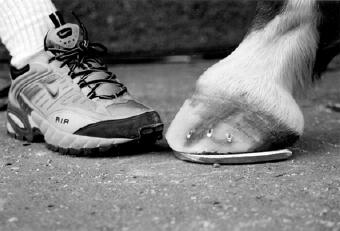
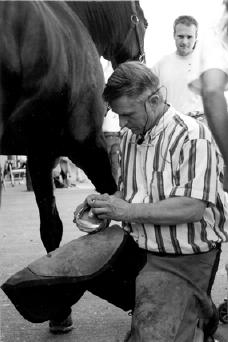
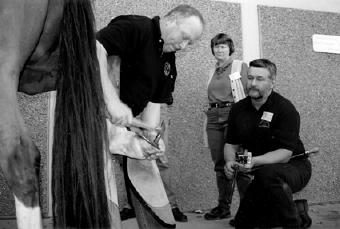 : British farriers David Nicholes (hammering) and
Clive Meers Rainger working on Feature Attraction.
: British farriers David Nicholes (hammering) and
Clive Meers Rainger working on Feature Attraction.
